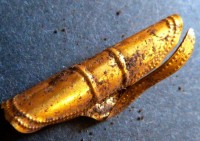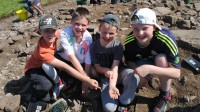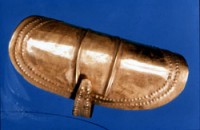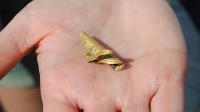 A group of boys seven to ten years old from Alston Primary School in Cumbria discovered a rare gold ornament from the Copper Age on an archaeological dig in Kirkhaugh, Northumberland. The ornament is a thin oval sheet of gold 1.3 inches long rolled into a semi-cylinder with two rows of repoussé dots along the outer perimeter and two parallel lines in the center crossing the width of the piece. On the rolled edge between the two lines is a long, thin tab also bordered in repoussé dots.
A group of boys seven to ten years old from Alston Primary School in Cumbria discovered a rare gold ornament from the Copper Age on an archaeological dig in Kirkhaugh, Northumberland. The ornament is a thin oval sheet of gold 1.3 inches long rolled into a semi-cylinder with two rows of repoussé dots along the outer perimeter and two parallel lines in the center crossing the width of the piece. On the rolled edge between the two lines is a long, thin tab also bordered in repoussé dots.
It’s not certain how they were meant to be worn. Called tress rings, they may have been hair tresses, worn wrapped around a braid or lock of hair. They’ve also been labeled “basket earrings” (because they look like the kind of curved edge basket ladies in period movies use to collect flowers from a garden) and may have been worn with the tab inserted into a piercing and then wrapped around the outside of the semi-cylinder. They would have hugged the outside of the ear like modern ear cuffs do.
 Aidan Bell (10), Luca Alderson (8), his brother Sebastian Alderson (10) and Joseph Bell (7) learned about the area’s Copper Age history in school and through a brilliant program called Dreaming the Land that draws on local archaeology and folklore and involves the children through art work and performance. That inspired them to participate in a community dig organized by the North Pennines Area of Outstanding Natural Beauty’s Altogether Archaeology project (which also organized Dreaming the Land), and next thing you know, they struck gold.
Aidan Bell (10), Luca Alderson (8), his brother Sebastian Alderson (10) and Joseph Bell (7) learned about the area’s Copper Age history in school and through a brilliant program called Dreaming the Land that draws on local archaeology and folklore and involves the children through art work and performance. That inspired them to participate in a community dig organized by the North Pennines Area of Outstanding Natural Beauty’s Altogether Archaeology project (which also organized Dreaming the Land), and next thing you know, they struck gold.
Seven-year-old Joseph Bell, one of the four boys to make the discovery, said: “We were digging carefully in the ground and I saw something shiny, it was gold. Me and Luca started dancing with joy. It was very exciting.” His friend, eight-year-old Luca Alderson, added: “When I first saw it I felt happy but I thought it was plastic. When I found out it was gold, I was very happy.”
 As well he should be. Not only is it gold, but at around 4,300 years old, it’s one of the earliest metal objects ever discovered in the UK and one of only 10 similar pieces known. One of those other nine was also unearthed at Kirkhaugh in 1935. It was found in a burial mound along with a decorated ceramic drinking vessel known as a beaker, the type artifact for and the late Neolithic/early Bronze Age Beaker Culture of western Europe, and a “cushion stone,” a flat-faced stone used as an anvil for crafting gold and copper.
As well he should be. Not only is it gold, but at around 4,300 years old, it’s one of the earliest metal objects ever discovered in the UK and one of only 10 similar pieces known. One of those other nine was also unearthed at Kirkhaugh in 1935. It was found in a burial mound along with a decorated ceramic drinking vessel known as a beaker, the type artifact for and the late Neolithic/early Bronze Age Beaker Culture of western Europe, and a “cushion stone,” a flat-faced stone used as an anvil for crafting gold and copper.
 The recently discovered piece was also found in a burial mound, this time accompanied by three flint arrowheads and a jet button. In a beautiful fluke of history, brothers Sebastian and Luca Alderson are the great-great-grandsons of Joseph William Alderson who worked on the 1935 dig. The newfound ornament and the 1935 one have the same decoration and dimensions. Archaeologists believe they are a matched pair and because of the cushion stone found in 1935, probably the work of professional metalworkers exploring the area for its mineable resources, the first in a long line of people who would seek to exploit the area’s richness in precious ores.
The recently discovered piece was also found in a burial mound, this time accompanied by three flint arrowheads and a jet button. In a beautiful fluke of history, brothers Sebastian and Luca Alderson are the great-great-grandsons of Joseph William Alderson who worked on the 1935 dig. The newfound ornament and the 1935 one have the same decoration and dimensions. Archaeologists believe they are a matched pair and because of the cushion stone found in 1935, probably the work of professional metalworkers exploring the area for its mineable resources, the first in a long line of people who would seek to exploit the area’s richness in precious ores.
[Altogether Archaeology leader Paul] Frodsham said: “When the metal worker arrived in the area I’m sure he’ll have been seen as someone very exotic and special because the chances are that no-one here will have ever seen a metal object until he showed up. We can only assume he was buried here, alone, because he was a long way from home and died unexpectedly.”
Prof. Fitzparick Andrew added: “I don’t think that it is a coincidence that the grave it is on the edge of the Alston ore field. I think the man buried at Kirkhaugh was part of a small group that was prospecting for copper over 4,000 years ago.”
The ornament and other artifacts will be studied by experts, after which the gold piece will hopefully be reunited with its 1935 brother currently on display at the Great North Museum in Newcastle.
“the kind of curved edge basket ladies in period movies use to collect flowers from a garden”: it’s called a trug. I’ll tell my wife that she lives in a period movie.
A great joy to read of such finds here History Blog. Worked for 35 years in the gold mining business and am amazed that my work was a continuation for a 5000 year history.
“brothers Sebastian and Luca Alderson are the great-great-grandsons of Joseph Alderson who worked on the 1935 dig”
Talk about keeping it in the family. 🙂
These kids are hooked for life now on treasure hunting. Great story.
That is the kind of history/science lessons kids need. In my opinion, slapping a textbook on their desk and saying “the test is Thursday for chapter 8” is not really that engaging. However, sending them on an archaeological dig is VERY engaging. 🙂 Lucky kids. 🙂
That’s the problem: archeology isn’t a treasure hunt.
This is a great find. It again reinforces the notion that they were pairs.
Great to see the kids having this experience.
This was far from a proper academically controlled dig. The site has been left as a complete mess – the once clear burial mound has been destroyed for ever. It’s a tragedy.
Are you sure the kids great granfather didn’t find it back than and just kept it and pass it down from father to son and so on ????????????????? :hattip: 😕
Are you sure the kids great grandfather didn’t find it back than and just kept it and pass it down from father to son and so on ????????????????? :hattip: 😕